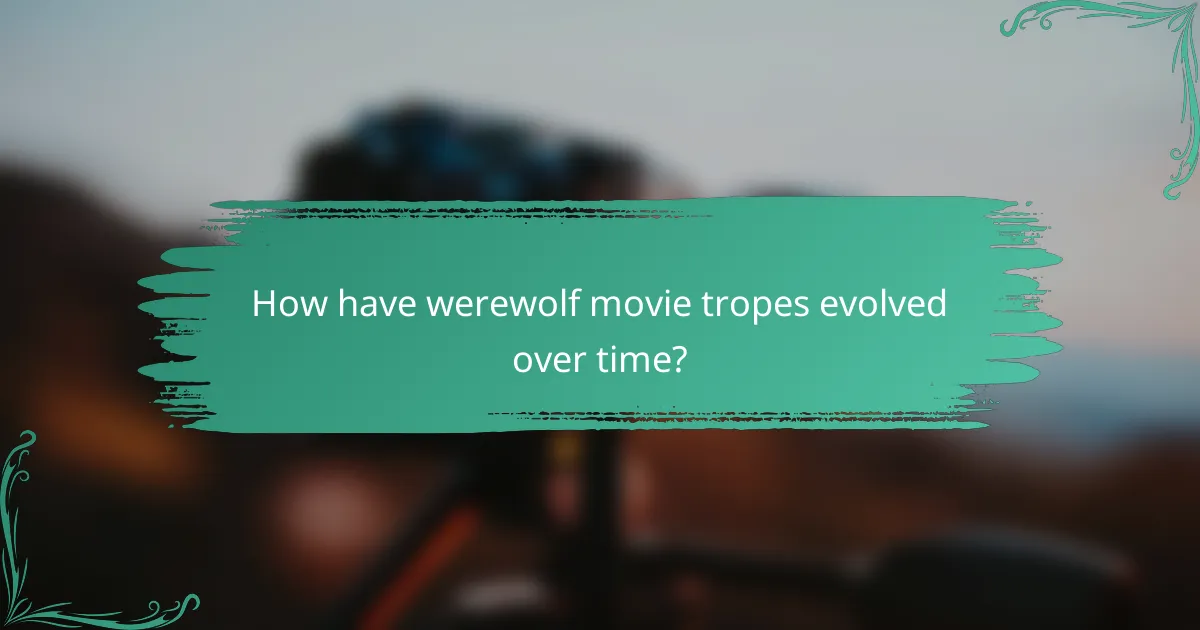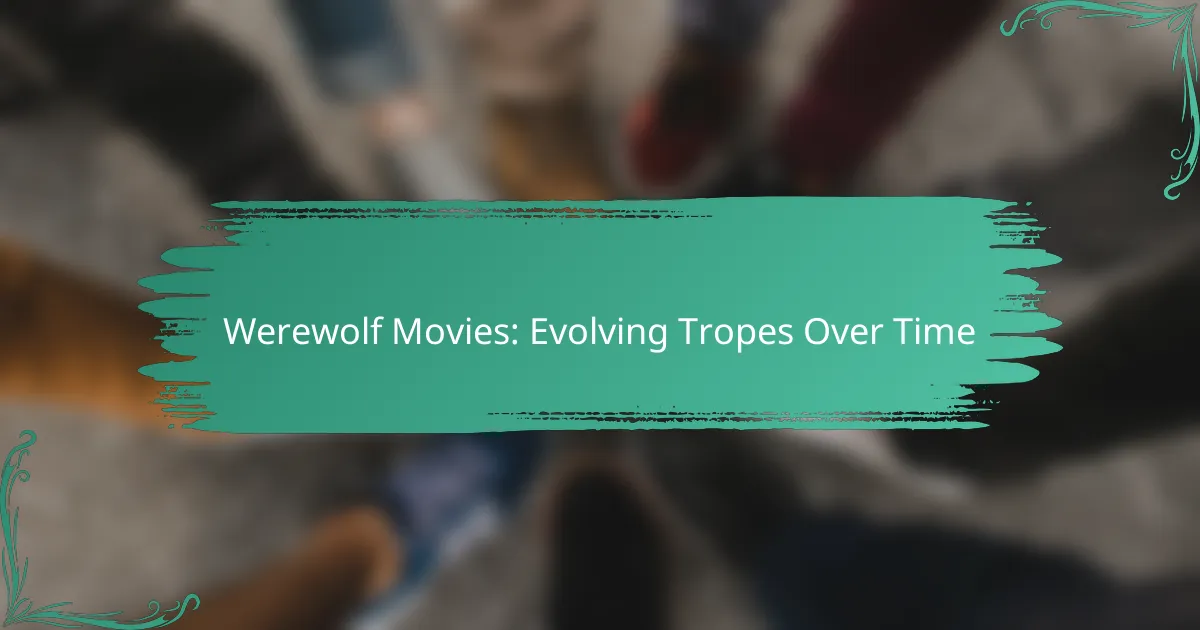Werewolf movies have evolved significantly over the years, transitioning from traditional horror to incorporate diverse storytelling and character development. This shift reflects changes in societal attitudes and advancements in filmmaking, allowing for more complex narratives that delve into themes of transformation, identity, and the human condition.

What are the most popular werewolf movies today?
Today, some of the most popular werewolf movies include titles that blend horror with unique storytelling and character development. Films like “Dog Soldiers” and “Ginger Snaps” have garnered cult followings, while newer entries like “Howl” and “Late Phases” continue to explore the werewolf mythos in fresh ways.
Dog Soldiers (2002)
“Dog Soldiers” is a British horror film that combines military action with werewolf lore. The plot follows a group of soldiers on a training exercise in the Scottish Highlands, who encounter a pack of werewolves. The film is noted for its intense action sequences and practical effects, making it a standout in the genre.
The film’s success lies in its blend of humor and horror, alongside strong character development. It has become a cult classic, often praised for its engaging storyline and memorable one-liners.
Ginger Snaps (2000)
“Ginger Snaps” is a Canadian film that redefines the werewolf narrative by focusing on female adolescence and transformation. The story revolves around two sisters, one of whom becomes a werewolf after a brutal attack. This film uses the werewolf metaphor to explore themes of puberty, identity, and societal expectations.
The film is celebrated for its clever writing and strong performances, particularly from the lead actresses. It has influenced many subsequent horror films, emphasizing character-driven narratives over traditional monster tropes.
The Wolfman (2010)
“The Wolfman” is a remake of the classic 1941 film, featuring a star-studded cast including Benicio del Toro and Anthony Hopkins. Set in Victorian England, it tells the story of a man who returns to his ancestral home and is bitten by a werewolf, leading to a struggle with his new identity. The film is known for its impressive visual effects and atmospheric cinematography.
While it received mixed reviews, “The Wolfman” is notable for its homage to classic horror, blending modern filmmaking techniques with traditional storytelling. It serves as a reminder of the enduring appeal of werewolf mythology in cinema.
Howl (2015)
“Howl” is a British horror film that takes a unique approach by setting the werewolf story on a train. Passengers become trapped on a train during a full moon, facing a terrifying creature outside. The film effectively builds tension and claustrophobia, making the setting a character in itself.
This film stands out for its suspenseful atmosphere and character interactions, showcasing how isolation can amplify fear. It appeals to fans of both horror and thriller genres, offering a fresh take on the werewolf trope.
Late Phases (2014)
“Late Phases” is a unique entry in the werewolf genre, focusing on an elderly blind man who confronts a werewolf in his retirement community. The film explores themes of aging, loss, and the fight for survival, providing a different perspective on the werewolf mythos.
Critically acclaimed for its character-driven narrative and emotional depth, “Late Phases” challenges conventional horror tropes. It resonates with audiences by blending horror with poignant storytelling, making it a noteworthy addition to contemporary werewolf films.

How have werewolf movie tropes evolved over time?
Werewolf movie tropes have shifted significantly from their origins in horror to encompass a wider range of genres and themes. This evolution reflects changing societal attitudes and advancements in filmmaking techniques, leading to more complex narratives and character portrayals.
From horror to comedy
Initially, werewolf films focused on horror elements, emphasizing fear and the monstrous nature of the transformation. Over time, many filmmakers began to incorporate comedy, creating a blend of humor and horror that appeals to a broader audience. Movies like “An American Werewolf in London” and “Teen Wolf” exemplify this shift, combining thrilling transformations with comedic scenarios.
This transition allows for a lighter take on the werewolf mythos, making it accessible to viewers who might not typically enjoy horror films. The comedic approach often highlights the absurdity of the situation, turning the terrifying into the entertaining.
Character complexity
Modern werewolf films have introduced more nuanced characters, moving beyond the one-dimensional monster trope. Filmmakers now explore the psychological and emotional struggles of characters dealing with their transformations, often portraying them as tragic figures. This complexity adds depth to the narrative, allowing audiences to empathize with the werewolf’s plight.
For instance, films like “The Howling” and “Ginger Snaps” delve into themes of identity and the human condition, showcasing how the werewolf transformation can serve as a metaphor for adolescence or personal conflict. This character-driven approach enriches the storytelling experience.
Modern special effects
The evolution of special effects technology has significantly impacted how werewolves are portrayed on screen. Earlier films relied on practical effects and makeup, which, while innovative for their time, often lacked realism. Today, CGI and advanced prosthetics allow for more believable transformations and lifelike creatures.
Movies such as “The Wolfman” and “What We Do in the Shadows” utilize these modern techniques to create visually stunning representations of werewolves. This advancement not only enhances the visual experience but also allows filmmakers to experiment with new storytelling methods, pushing the boundaries of the genre.

What are the key themes in werewolf movies?
Werewolf movies often explore themes of transformation, identity, isolation, and the conflict between nature and nurture. These elements reflect deeper human fears and societal issues, making the genre both compelling and relatable.
Transformation and identity
Transformation is a central theme in werewolf films, symbolizing the struggle between human and beast. Characters often face a physical metamorphosis that mirrors their internal conflicts, leading to questions about their true identity. This duality can evoke empathy, as viewers witness the character’s battle with their primal instincts.
For example, films like “An American Werewolf in London” showcase the protagonist’s transformation as both a curse and a loss of self. This theme resonates with audiences, highlighting the fear of losing control over one’s identity.
Isolation and community
Isolation is frequently depicted in werewolf narratives, emphasizing the alienation felt by those who are different. The werewolf’s curse often leads to estrangement from family and friends, creating a poignant commentary on societal rejection. This theme illustrates the struggle for acceptance in a world that fears the unknown.
Conversely, some films explore the dynamics of community, where werewolves band together for survival. This sense of belonging can provide comfort, yet it also raises questions about loyalty and the consequences of group mentality. Movies like “The Howling” delve into these complex relationships, showcasing both the strength and vulnerability of community ties.
Nature vs. nurture
The debate of nature versus nurture is prevalent in werewolf films, questioning whether the beast within is a product of genetics or environment. This theme invites viewers to consider the impact of upbringing and societal influences on behavior. Characters often grapple with their instincts, leading to moral dilemmas about their actions.
For instance, in “Ginger Snaps,” the transformation into a werewolf serves as a metaphor for adolescence and the changes that come with it. The film explores how external factors, like family dynamics and societal expectations, shape one’s identity and choices, making the theme particularly relevant to young audiences.

Which werewolf movies have influenced pop culture?
Several werewolf movies have significantly shaped pop culture, introducing iconic tropes and themes that resonate today. These films have redefined the werewolf mythos, blending horror with humor, and influencing subsequent media portrayals.
American Werewolf in London (1981)
“American Werewolf in London” is a landmark film that combined horror and dark comedy, setting a new standard for werewolf transformations. Its groundbreaking special effects, particularly the transformation scene, showcased the potential for visual storytelling in horror cinema.
The film’s mix of humor and terror influenced many subsequent werewolf movies, establishing a template for balancing these elements. It also introduced the concept of the werewolf as a tragic figure, struggling with their dual nature, which has become a recurring theme in later works.
Teen Wolf (1985)
“Teen Wolf” took a different approach by blending teen comedy with supernatural elements, making the werewolf relatable to younger audiences. The film’s portrayal of the werewolf as a metaphor for adolescence resonated with viewers, highlighting themes of identity and acceptance.
This lighthearted take on the werewolf mythos paved the way for future teen-centric supernatural stories, emphasizing personal growth alongside fantastical elements. The character of Scott Howard became an archetype for the “reluctant hero,” influencing countless coming-of-age narratives.
Buffy the Vampire Slayer (TV Series)
The “Buffy the Vampire Slayer” TV series expanded the werewolf trope within a broader supernatural context, introducing the character of Oz, a werewolf who navigates his dual identity while being a member of the Scooby Gang. This portrayal added depth to the werewolf narrative, focusing on personal struggles and relationships.
By integrating werewolves into a larger ensemble cast of supernatural beings, the series highlighted the complexities of being a werewolf in a modern setting. This approach influenced many subsequent shows, encouraging more nuanced representations of werewolves and their interactions with other supernatural creatures.

What are the common characteristics of werewolf films?
Werewolf films typically feature themes of transformation, conflict, and mythology. Common characteristics include the full moon transformation, ties to mythical lore, and the struggle between the werewolf and humanity.
Full moon transformation
The full moon transformation is a defining trait of werewolf films, symbolizing the uncontrollable nature of the beast within. During this phase, characters often undergo a dramatic change, losing their human consciousness and becoming feral. This transformation can be depicted through various special effects, ranging from practical makeup to CGI.
In many films, the transformation is not just physical but also emotional, showcasing the character’s internal struggle. For instance, some narratives explore the fear and guilt associated with becoming a werewolf, adding depth to the horror element.
Mythical lore
Mythical lore plays a significant role in shaping werewolf narratives, often drawing from ancient legends and folklore. Many films reference traditional stories about curses, bite infections, or bloodlines that dictate werewolf traits. This connection to mythology enhances the film’s authenticity and provides a rich backdrop for the story.
Common motifs include the idea of werewolves as protectors of nature or as victims of their own fate. These themes can vary widely, with some films portraying werewolves as tragic figures while others depict them as malevolent creatures.
Conflict with humanity
Conflict with humanity is a central theme in werewolf films, often highlighting the struggle between the beast and human morality. This conflict can manifest in various ways, such as the werewolf’s desire to coexist with humans versus the instinct to hunt and kill. The tension between these opposing forces drives the narrative forward.
Additionally, societal reactions to the werewolf can reflect broader themes of fear and misunderstanding. Characters may face persecution or isolation, mirroring real-world issues of discrimination and acceptance. This adds layers to the story, making it more relatable and thought-provoking for the audience.

How do werewolf movies compare to other horror genres?
Werewolf movies often blend elements of transformation and primal instincts, distinguishing them from other horror genres. They typically explore themes of duality and the struggle between humanity and animalistic urges, setting them apart from more supernatural or psychological horror films.
Vs. vampire films
Werewolf films differ significantly from vampire movies in terms of their portrayal of transformation and the nature of the threat. While vampires often represent seduction and immortality, werewolves embody the fear of losing control and the raw power of nature.
The transformation in werewolf films is usually depicted as painful and involuntary, emphasizing the character’s struggle against their beastly nature. In contrast, vampires often choose to embrace their identity, which can lead to a more romanticized view of their existence.
Additionally, werewolf narratives frequently focus on the consequences of the transformation, such as isolation and guilt, whereas vampire stories may explore themes of eternal life and moral ambiguity. This fundamental difference shapes the emotional impact and audience connection in each genre.
